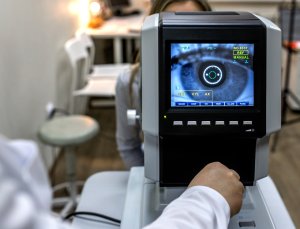Diabetic Eye Center

Voted Best of Berks—
eight years in a row!
The American Diabetes Association (ADA) estimates that 17.9 million Americans have been diagnosed with diabetes, and approximately 5.7 million more have the disease but it is undiagnosed. Prolonged high levels of blood sugar in patients with diabetes can lead to oxidative stress, inflammation, and vascular damage causing microvascular complications that severely impair a patient’s quality of life. One such microvascular complication is diabetic retinopathy (DR), which is responsible for 12,000 to 24,000 new cases of blindness in the United States each year and is the leading cause of blindness among U.S. adults aged 20 to 74 years. With the rise of diabetes in the United States, it is estimated that the number of Americans aged 40 or more years who have DR will triple from 5.5 million in 2005 to 16 million by the year 2050.
Our team of eye specialists at the Eye Consultants of Pennsylvania are here to help you manage your diabetic retinopathy and prevent blinding eye disease. Below are answers to some common questions:
What is the retina?
The retina is the thin layer of tissue that lines the inside of the eye. The retina functions like the film of a camera. When focused light hits the retina, a picture is taken. Messages about the picture are sent to the brain through the optic nerve. The brain then interprets these pictures which is how we see. Please watch video #1 for more information on the retina.
What is diabetic retinopathy?
In diabetic retinopathy, the blood vessels of the retina become damaged by high blood sugars. There are two major categories of diabetic retinopathy: (1) nonproliferative and (2) proliferative diabetic retinopathy. In nonproliferative diabetic retinopathy (NPDR), damaged blood vessels leak fluid and blood into the retina. Please watch video #2 for additional information on NPDR.
Why do patients lose vision from diabetic retinopathy?
In diabetic retinopathy, the retinal blood vessels develop tiny leaks which seep into the retina, especially the macula. When fluid accumulates in the macula and causes swelling, the central vision may become blurred. This condition is called macular edema and is often treated with laser. In some cases, the blood supply to the macula becomes affected, and ischemia develops. Please watch video #3 for additional information on macular disease, and watch video #4 for information on laser treatment for macular edema.
What is proliferative diabetic retinopathy?
Proliferative diabetic retinopathy (PDR) is the advanced form of diabetic retinopathy which develops when new blood vessels grow in response to severe ischemia. The growth of new blood vessels is called neovascularization. These new blood vessels are abnormal and may cause severe bleeding, glaucoma, and retinal detachment. Neovascularization is often treated by applying laser to the peripheral ischemic retina. Please watch video #5 for additional information on PDR and watch video #6 for information on laser treatment for PDR.
What is the purpose of laser surgery?
In nonproliferative diabetic retinopathy (NPDR), leaking blood vessels can cause macular edema and loss of vision. The goal of laser in NPDR is to stop the leakage and prevent further vision loss. In proliferative diabetic retinopathy (PDR), neovascularization can cause severe loss of vision by bleeding (vitreous hemorrhage) and by developing scar tissue that can pull on the retina and cause a retinal detachment. The goal of laser in PDR is to stop the growth of new blood vessels and prevent these complications. Please watch video #4 for additional information on laser treatment for macular edema, and watch video #6 for information on laser treatment for PDR.
When do patients with diabetic retinopathy need surgery?
In some cases of proliferative diabetic retinopathy (PDR), the new blood vessels can cause severe bleeding called a vitreous hemorrhage. This bleeding can block the vision, and block the ability of your eye doctor to perform laser treatments. Furthermore, neovascularization can lead to retinal detachment putting the patient at risk for severe vision loss. In these cases, your retinal specialist may recommend surgery to remove the blood or repair the retinal detachment. Please watch video #7 for information in vitreous hemorrhage, and video #8 for information on surgery.
About Eye Consultants of Pennsylvania, PC
Eye Consultants of Pennsylvania, PC, is the leading ophthalmology practice in the region. All of our doctors are Board Certified and our services span the full range of eye care. We have four convenient locations in Wyomissing, Pottsville, Pottstown and Blandon. Daytime and evening hours are available.
Our Retina Specialists utilize the latest technology and enjoy an excellent reputation — one of high patient satisfaction and outstanding results. From the first moment a friendly staff member greets you until your surgery is performed in one of our state-of-the-art surgical suites, you’ll receive the compassionate care and personal attention that you deserve.
Make your appointment to meet one of our Retina Specialists and discover how we can make your world a brighter, clearer place.
Find a Doctor
Physician information including education, training, practice location and more.
Schedule an Appointment
Call 800-762-7132 or make an appointment online.





